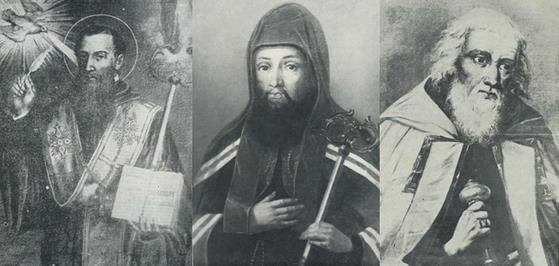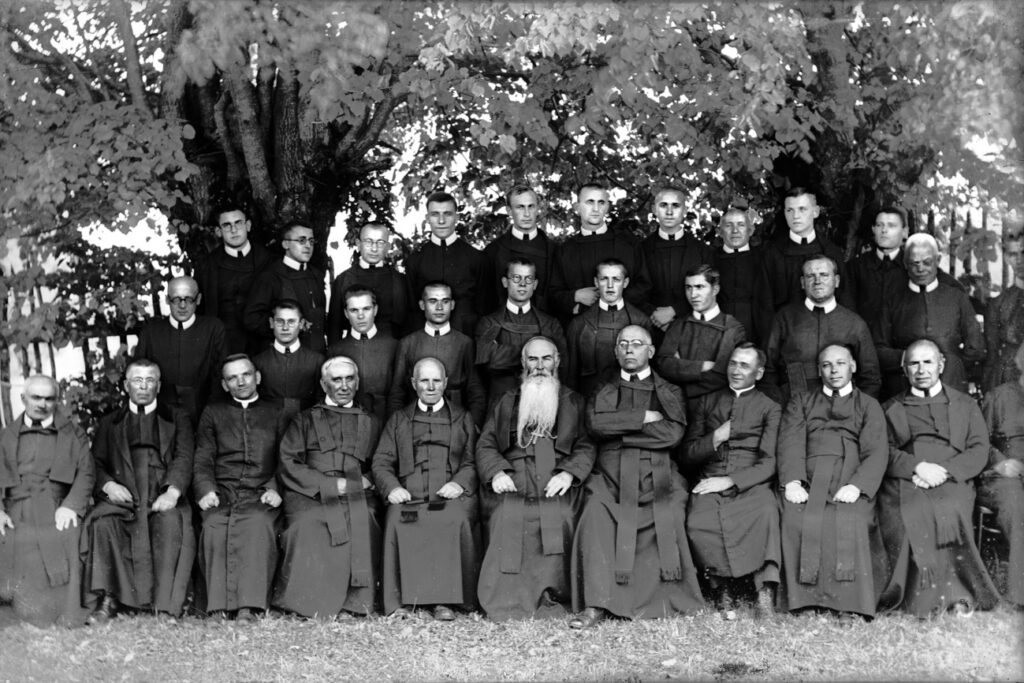Brief history of the Order
St. Basil the Great (329-379) is regarded as the founder of coenobitic monasticism. Along with other ascetic works, his Rules (Longer and Shorter) constitute to this day the basis for those orders and congregations which call themselves Basilian.
The roots of typically eastern Christian monasticism on Ukrainian territory reach back to the reign of Volodymyr the Great (980-1015) Prince of Kyivan Rus, when the first monks settled in the neighbourhood of Kyiv. St. Anthony Pechersky (+1073) and especially his follower St. Theodosius (+1074) had the greatest influence on this monasticism. After the Tartar incursions of the mid thirteenth century ruined Kyivan Rus, monks searched for places in the northern and western parts of the principality, and founded new monasteries. In this way, they arrived in the Galician-Volhynian principalities, which were subsequently came within the boundaries of the Kingdom of Poland and the Grand Duchy of Lithuania.

After the renewal of unity between the Metropolia of Kyiv with the Catholic Church in 1596, Metropolitan Joseph Veliamin Rutsky and St. Josaphat Kuncevych played a fundamental role in creating a new way of monastic life. At the beginning of the seventeenth century, they carried out a deep reform of monastic life, giving it a structure similar to that of the monastic orders of that time. First, they monastically formed a group of young and educated candidates in the monastery in Vilnius (1608-1616). When the group grew enough to encompass five monasteries, Metropolitan Joseph summoned them to the village of Novhorodovych to the first Chapter, which took place from July 19 to 26, 1617. The “Basilian Congregation of the Most Holy Trinity” was created at this first meeting with the following organization. The head of the new community was the Metropolitan. Internally, the protoarchimandrite, along with four advisors, directed the monasteries and the monks. A general chapter was supposed to take place every four years to discuss and decide various issues. Metropolitan Rutsky laid down rules for this Congregation under the name: “Common Rules of Our Holy Father Basil the Great,” and the “Particular Rules for Specific Offices.” On October 20, 1631, Pope Urban VIII confirmed the decree of the Congregation for Eastern Churches, “He Taught Us,” itself dated October 4, 1624. Its subject matter was the unification of the “Ruthenian Monks.” This officially created the Basilian Congregation of the Most Holy Trinity, also known as the Lithuanian Congregation.
In 1720, the Synod of Zamosc directed the monasteries of the eparchies of Volodymyr, Lutsk, Kholm, Lviv and Peremyshl that had entered into union with Rome, but which still retained their old eastern way of life, to unite into one congregation, similar to the Congregation of the Most Holy Trinity. This took place in 1739 at the chapter in Lviv, called by Metropolitan Athanasius Sheptytsky. This founded the “Congregation of the Protection of the Most Holy Mother of God,” also known as the Ruthenian Congregation. The new Congregation accepted the rules of the Congregation of the Most Holy Trinity, but did not wish to join it. Pope Benedict XIV was present at the meeting of the Congregation of the Propagation of the Faith on 1.05.1742 where the arguments for and against unification were examined. He decided to unify both congregations into one Order and published a decree to this effect. At that time, the Congregation of the Most Holy Trinity had 66 monasteries and 445 monks. The newly created Congregation of the Most Holy Mother of God had 129 monasteries and about 700 monks. The unification was completed at the chapter in Dubno in 1743. Pope Benedict XIV confirmed the constitutions accepted at the chapter in Dubno with the decree “Among Many,” dated May 2, 1744. He gave the new union the name: “Ruthenian Order of St. Basil the Great.”
The united Basilian Order experienced its greatest growth from that time. This was due to the Kyivan Metropolitan Joseph Veliamin Rutsky, who initiated a great and new project in the Eastern Church – to unify many monasteries under a single leadership. He did this with the aim of using monks for the good of the whole Church. In this way, the reformed Order grew dynamically in the XVIII century. This is attested by the fact that the Basilians were able to take over many Jesuit schools after the suppression of the Jesuit order. They ran more than 20 colleges. The greatest number of students were in the city of Bar, more than 800. The city of Sharhorod had 600 students. Other places had between 200 and 500 students. Besides the colleges, the Basilians had schools for their own students. They also ran eparchial seminaries and they ran many parochial schools at their monasteries. Besides educational activity, the Basilians dedicated the most time and effort to pastoral work. They managed parishes at their monasteries, assisted in secular parishes, were chaplains to nuns’ monasteries, and organized spiritual missions among the people. Publishing activity was also characteristic of the Order. Basilian publishing houses existed in Vilnius, Suprasl, Univ, but the most famous was in Pochaiv, which printed a large quantity of great books for that time (more than 300). There were around 30 notable Basilian writers between the XVII and XVIII centuries.
There were 155 monasteries in 1772 in Right-Bank Ukraine (Podilya, Volyn, Pidliashsha, Kholm, and in Lithuania and Belorussia. There were 1235 monks. Up to 1839, the Order provided almost all the metropolitans of Kyiv and around 60 bishops, not including many of their assistants.
The Order was divided into four Provinces in 1780: the Most Holy Trinity (Lithuanian), the Protection of the Most Holy Mother of God (Ruthenian or Polish), St. Nicholas (Belorussian) and the Most Holy Saviour (Galician). Nevertheless, after 1795, when three of the Provinces came under Russia, monastic life was completely liquidated by 1839 due to unfavourable political conditions. Many monks were imprisoned or exiled deep into Russia. Others were driven away or forcibly taken into Russian monasteries. With difficulty, the Order persisted within the bounds of the Austrian empire, where, by 1882, only 14 monasteries with 60 members were left as a result of state reforms.

Nevertheless, Divine Providence again led to a rebirth of monastic life, and as a result, of the Greek Catholic Church. At the end of 1882, Fr. Clement Sarnyckyj, provincial superior of the Province of the Most Holy Saviour, appealed to Pope Leo XIII to allow representatives of the Society of Jesus to carry out a reform of the Order. Pope Leo XIII published the letter “By the Special Protection” on May 12, 1882, which laid out the plan of the reform, which has gone into history under the name of “The Dobromyl Reform” from the name of the monastery where the reform was carried out. The reform was officially concluded in 1904. 47 Jesuits contributed.
After the reform was completed, the Basilians expanded their activity in missions, retreats, pastoral work, publishing, and research. One cannot forget to mention eminent figures in the Order and the Church such as Metropolitan Andrey Sheptytsky, the beatified bishops Josaphat Kotsylovsky, and Paul Goydych, bishop Josaphat Fedoryk, Fathers Platonid Filas, Jeremiah Lomnytsky, Dionysius Tkachuk, Meletius Lonchyna, Lazar Berezovsky, Julian Datsy, Paul Teodorovych, Josaphat Skruten, Roman Lukan, Andrew Truch, and many others.
During the time of the Dobromyl Reform (end of the 19th to the beginning of the 20th centuries), the need arose for pastoral service in the diaspora. The reformed Basilians set out to Brazil (1897 – Fr. Sylvester Kizyma), to Canada (1902 – Fr.’s Platonid Filas, Sozont Dydyk and Anton Strotsky), to America (1907 – Bishop Soter Ortynsky and Fr. Volodymyr Stekh). Other monks came later on. Other provinces were created before 1939 in addition to the Galician one: St. Nicholas, which included Transcarpathia, Hungary and Yugoslavia, the American-Canadian province, the vice-provinces of St. Joseph in Brazil and in Romania. The Province of the Sacred Heart then included 378 members. The Province of St. Nicholas included 163. The American-Canadian Province included 92 monks. There were 14 monks in Brazil, and 39 in Romania. Altogether there were 652 monks (206 priest monks, 192 students and 254 brothers).
The advent of Soviet rule in 1939 into Galicia brought a new trial of faith. The organs of the NKVD tortured to death two Basilians in Drohobych: Joachim Senkivsky and Severian Baranyk. They were the first victims. Between 1945 and 1950, the communist authorities liquidated all the monasteries in the European provinces and imprisoned or exiled the monks to Siberia. Others were tortured or driven away. Over 70 priest-monks were exiled to Siberia. Nevertheless, the monks did not cease their active work. They continued their monastic life and activity illegally as permitted by time and circumstances. Although they needed to work at various jobs and were monitored by the security services, they still ran an underground novitiate, they served monastic sisters and numerous faithful, to whom they distributed the Holy Sacraments. The monks of the overseas Provinces could productively work and grow, especially the Brazilian Province, which grew to 126 monks in 1989, with 57 hiero-monks. In 1989, the Province of the Most Holy Saviour in Ukraine included 91 monks, of which 50 were priests.
The year 1990 brought the desired freedom and rebirth of religious life. In Ukraine, the process of returning and renovating confiscated monasteries started. They had greatly deteriorated through 45 years and almost all of them had been turned into hospitals, and in the better cases, into dormitories.
Renovations of the most important monasteries took fifteen years, and new ones were founded: in Bar, Pokotylivstya near Kharkiv, in Lutsk, Volodymyr-Volynsk, Kyiv, and Briukhovychi. Briukhovychi has been the location of the “Metropolitan Joseph V. Rutsky Basilian Institute of Philosophical and Theological Studies” since 2002. New monasteries were also founded in Zvankivka & Chortkiv and Vilnius (Lithuania).
The size of the Basilian Order in 2022 was 502 monks in 9 Provinces (not including candidates): Argentina: (8), Brazil (86), Canada (18), Hungary (9), Poland (16), Romania (13), Slovakia (9), Ukraine (303), USA (22).
A few other Orders exist in the Eastern Catholic Churches named after St. Basil. These are the Basilians in Grottoferatta near Rome, Italy (Italo-Greeks); Basilians of the Sacred Heart, Basilians of St. John the Baptist, Alipinian Basilians (these three belong to the Melchite Church). There also exists the Congregation of St. Basil in the Latin Rite.

 Basilian Order of Saint Josaphat
Basilian Order of Saint Josaphat 

